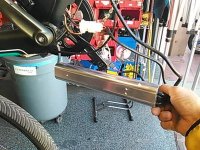So in chasing power and speed I enjoy a high voltage setup. Less bulky wiring less amps through connectors etc.
Where do u draw the line ? I run 130v full charge, I have run 160v but all in the line of chasing kw with a wide power band on a mxus 5T. Safety is a concern, higher voltage = higher chance of conductivity through skin yeh ? Lower volts are safer irrelevant of amps , higher amps means nothing if conductivity is low.
but all in the line of chasing kw with a wide power band on a mxus 5T. Safety is a concern, higher voltage = higher chance of conductivity through skin yeh ? Lower volts are safer irrelevant of amps , higher amps means nothing if conductivity is low.
This brings me to controllers , I want 10kw on an ebike, so 100v @ 100 amps and my controller is still a nice size. I want to go safe so I go 50v @ 200 amps, but now my controller is massive ! And my wires are huge. I take it controllers are massive due to needing bigger traces ? Caps would be same size ?
Where is the safe level ? Most ebikes are @ 48v tops , there must be some safety reason for this, I'd say above and it jumps skin easily.
Mmmmm I need to find a small 200 amp controller to be safe ..... but where ?
Where do u draw the line ? I run 130v full charge, I have run 160v
This brings me to controllers , I want 10kw on an ebike, so 100v @ 100 amps and my controller is still a nice size. I want to go safe so I go 50v @ 200 amps, but now my controller is massive ! And my wires are huge. I take it controllers are massive due to needing bigger traces ? Caps would be same size ?
Where is the safe level ? Most ebikes are @ 48v tops , there must be some safety reason for this, I'd say above and it jumps skin easily.
Mmmmm I need to find a small 200 amp controller to be safe ..... but where ?



